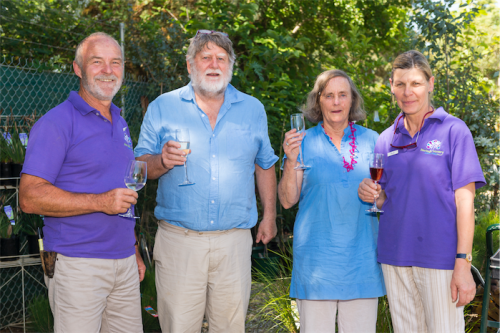
It is a genus of more than 300 species of deciduous and evergreen climbers. The large-flowered hybrids are the most popular.
Its flowers are comprised of 4-8 sepals, the true petals are absent in almost all clematis.
 Clematis flowers in all seasons, although the large-flowered varieties appear mainly in late spring to early summer. Mid-winter flowering clematis includes Clematis napaulensis, a vigorous climber with cream-coloured flowers and purple centre. It was first discovered by the famous plant hunter George Forrest in China in 1912.
Clematis flowers in all seasons, although the large-flowered varieties appear mainly in late spring to early summer. Mid-winter flowering clematis includes Clematis napaulensis, a vigorous climber with cream-coloured flowers and purple centre. It was first discovered by the famous plant hunter George Forrest in China in 1912.
I combined this with Rosa “Crepuscule”, a beautiful apricot climbing rose over an arch.
In summer we are provided with the colour of the rose and in winter, when the rose is bare, the clematis flowers. After flowering, clematis is referred to as “Old Man’s Beard” due to the silver-grey of the fluffy seed pods.
Clematis cirrhosa is an evergreen, winter-flowering variety that I have growing over an arch in our front garden. The profusion of small, creamy-white flowers are a joy. It comes from southern Europe and North Africa, and has been recorded in gardens since 1596. There are several varieties of this clematis, ours is C. cirrhosa “Wisley Cream”.
ON a trellis in our rear garden, we have five clematis including the illustrated C. “General Sikorski”, plus C. “Romantika”, C. “Ernest Markham” and the early spring flowering C. montana rubens, a vigorous climber with white or pink-tinged flowers.
Due to its vigour, it is ideal for growing over sheds and, in times past, was popular for growing over outdoor dunnies.
Clematis is in full flower at local garden centres and now’s an ideal time to choose the colours.
These are all combined with that rose I rave on about; the climbing thornless Rosa “Zephirine Drouhin”, an old French rose from 1858 with possibly the most fragrance of all roses.
It is used in Europe extensively for pot-pourri. Those who have seen it growing on the northerly side of our house often remark: “For once Cedric, you are not exaggerating”.
An example is growing at the entrance to Heritage Nursery in Yarraluma, although it does not do it justice there. I did explain to owner Bruno that he would run out of these when they arrived in late winter, particularly when I featured them in this column and, sure enough, he did! He has managed to find some more.

Bruno Zimmerman, left, Clive and Penny Blazey with Hedy Zimmerman celebrate the arrival of Diggers Seeds at Heritage Nursery.
Many old varieties of vegetables were disappearing as the large seed companies dropped lines they couldn’t sell, which concerned the Blazeys enough to want to rescue and continue to make them available.
Putting action into words, in 1978 the first seed catalogue was posted out listing an amazing 300 varieties.
While ostensibly a mail-order business, Clive and Penny Blazey have partnered with Bruno and Hedy Zimmerman, of the Heritage Nursery in Yarralumla, to offer locally a range of Diggers organic seeds.
Jottings…
- Look out for the new Martin’s “Pelletised Lucerne”. Expands four times and a bag covers nine square metres. Better than cane or pea straw.
- Take out dead leaves of bearded iris, a hiding place for snails.
- Prune spring and early flowering shrubs such as Deutzia, Philadelphus, Kolkwitzia and Weigela.
- Dead head delphiniums and lupins to encourage a second flowering.
Who can be trusted?
In a world of spin and confusion, there’s never been a more important time to support independent journalism in Canberra.
If you trust our work online and want to enforce the power of independent voices, I invite you to make a small contribution.
Every dollar of support is invested back into our journalism to help keep citynews.com.au strong and free.
Thank you,
Ian Meikle, editor




Leave a Reply